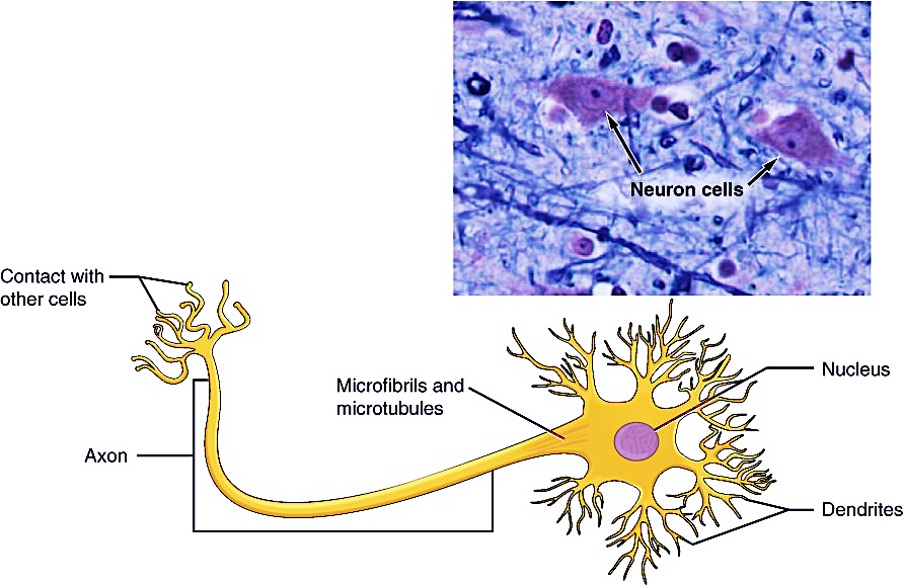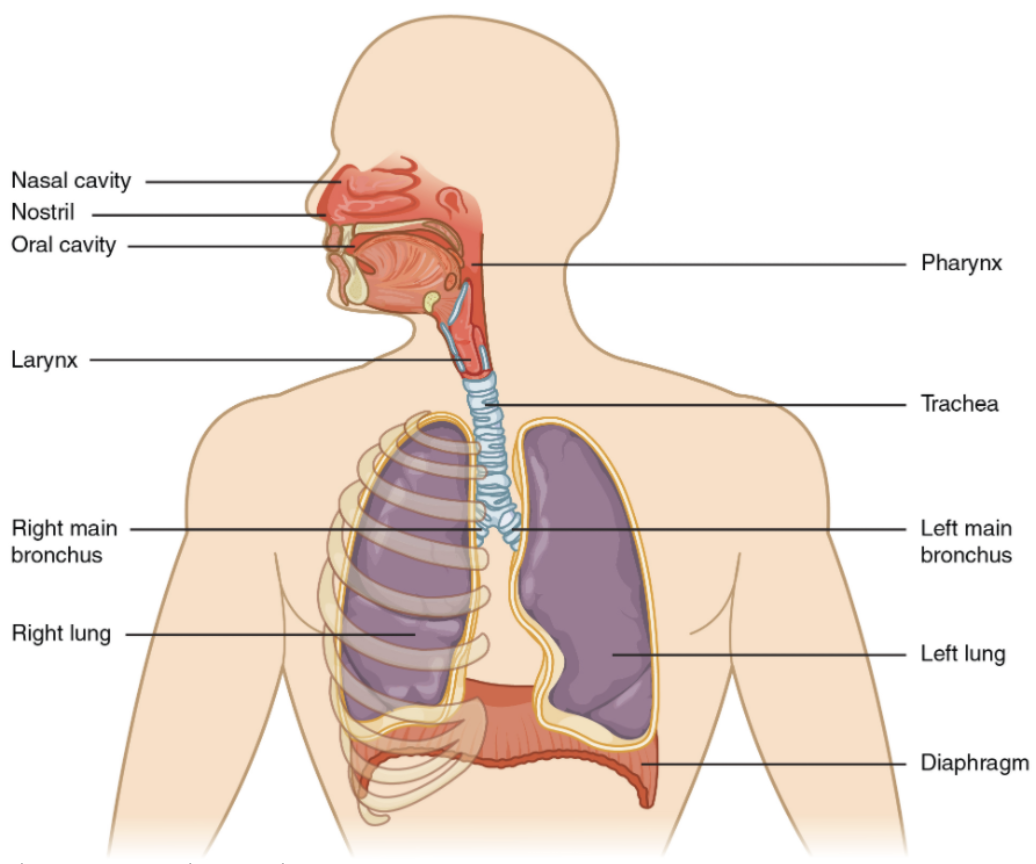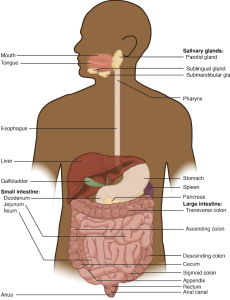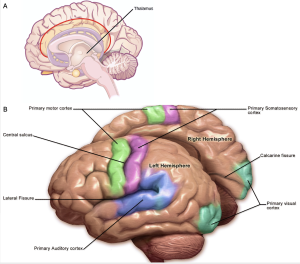17 Organs and systems
Endocrine
The endocrine system is a network of glands that communicate with cells throughout the body by releasing hormones. Key components include the hypothalamus, pituitary gland, adrenal gland, thyroid gland, parathyroid gland, and pancreas. The hypothalamus links the nervous system to the endocrine system, controlling the pituitary gland. The pituitary gland regulates other endocrine glands and various bodily functions. The adrenal glands produce hormones like cortisol and adrenaline, which help manage stress and metabolism. The thyroid gland regulates metabolism, growth, and development through thyroid hormones. The parathyroid glands maintain calcium levels in the blood, crucial for nerve and muscle function. The pancreas has both endocrine and exocrine functions; it regulates blood sugar levels by releasing insulin and glucagon. Together, these glands ensure the body maintains homeostasis by coordinating complex processes through hormonal signals.
Nervous
The nervous system is a complex network responsible for communication between cells through electric signals and neurotransmitter release (Figure 4.4). It consists of the brain, spinal cord, and peripheral nerves. The brain is the control center, processing sensory information, coordinating responses, and managing cognitive functions. It sends and receives signals to and from the body. The spinal cord acts as a conduit for signals between the brain and the rest of the body, also playing a role in reflex actions. Peripheral nerves extend from the spinal cord to various parts of the body, transmitting signals to and from the central nervous system. These nerves are divided into sensory nerves, which carry information to the brain, and motor nerves, which carry commands from the brain to muscles and glands. Together, these components ensure rapid and precise communication, enabling the body to respond to internal and external stimuli efficiently.

Musculoskeletal
The musculoskeletal system is essential for supporting the body and enabling voluntary movement. It comprises skeletal muscles, bones, tendons, and ligaments. Skeletal muscles are responsible for voluntary movements, such as walking and running. They contract and relax in response to signals from the nervous system, allowing precise control over body movements. Bones provide the rigid framework that supports the body and protects vital organs. They also serve as attachment points for muscles, facilitating movement.
Tendons are strong, fibrous tissues that connect muscles to bones, transmitting the force generated by muscle contractions to the skeleton, enabling movement. Ligaments are tough bands of tissue that connect bones to other bones at joints, providing stability and guiding joint movements. Together, these components work to support the body, maintain posture, and allow a wide range of voluntary movements.
Cardiovascular
The mammalian cardiovascular system is crucial for transporting nutrients and other molecules throughout the body. It consists of the heart, blood vessels, and blood. The heart is a muscular organ that pumps blood through the circulatory system. It ensures that oxygen-rich blood reaches tissues and organs while removing carbon dioxide and other waste products. The heart’s rhythmic contractions maintain a continuous flow of blood. Blood vessels include arteries, veins, and capillaries. Arteries carry oxygenated blood away from the heart to the body’s tissues. Veins return deoxygenated blood back to the heart. Capillaries are tiny vessels where the exchange of oxygen, nutrients, and waste products occurs between blood and tissues. Blood is the fluid that circulates through the cardiovascular system. It transports oxygen, nutrients, hormones, and waste products. Red blood cells carry oxygen, white blood cells fight infections, and platelets help with blood clotting. Together, these components ensure that essential substances are delivered to cells and waste products are removed, maintaining overall health and homeostasis.
Respiratory
The respiratory system is essential for the intake of oxygen and the elimination of carbon dioxide from the body. It includes the lungs, trachea, pharynx, larynx, bronchi, bronchioles, and alveoli (Figure 4.5). The lungs are the primary organs where gas exchange occurs. Air enters the body through the trachea, which splits into the bronchi. The bronchi further divide into smaller bronchioles, leading to the alveoli, tiny air sacs where oxygen is absorbed into the blood, and carbon dioxide is expelled. The pharynx and larynx are part of the upper respiratory tract. The pharynx serves as a pathway for air to enter the trachea, while the larynx, or voice box, contains the vocal cords and is involved in sound production. Together, these structures ensure that oxygen is delivered to the bloodstream and carbon dioxide is removed, and contributing to overall homeostasis.

Urinary
The urinary system plays a crucial role in filtering the blood and eliminating waste products from the body. It consists of the kidneys, ureters, urinary bladder, and urethra. The kidneys are the primary organs responsible for filtering blood. They remove waste products, excess substances, and toxins, producing urine in the process. The filtered blood is then returned to the circulatory system. Ureters are tubes that transport urine from the kidneys to the urinary bladder, where it is stored until it is ready to be expelled from the body. The bladder’s muscular walls allow it to expand and hold urine until urination. The urethra is the final pathway through which urine is expelled from the body. In males, the urethra also carries semen during ejaculation. Together, these components ensure that waste products are efficiently removed from the body, maintaining fluid and electrolyte balance, and contributing to overall homeostasis.
Gastrointestinal (GIT)
The mammalian gastrointestinal system is essential for digesting food and absorbing nutrients. It includes the mouth, oesophagus, stomach, intestines, liver, gall bladder, and pancreas (Figure 4.6). The mouth is where digestion begins, with teeth breaking down food and saliva starting the chemical digestion process. The oesophagus is a muscular tube that transports food from the mouth to the stomach through peristaltic movements. The stomach further breaks down food using stomach acids and enzymes, turning it into a semi-liquid mixture called chyme. The intestines (small and large) are where most nutrient absorption occurs. The small intestine absorbs nutrients and minerals, while the large intestine absorbs water and forms solid waste. The liver produces bile, which helps digest fats, and the gall bladder stores and releases bile into the small intestine. The pancreas produces digestive enzymes and bicarbonate, which neutralise stomach acid and aid in digestion. Together, these organs ensure that food is efficiently digested and nutrients are absorbed, supporting the body’s overall health and function.

Reproductive
The mammalian reproductive system is essential for generating offspring. It includes the gonads, reproductive tracts, and associated glands. Gonads are the primary reproductive organs. In males, these are the testes, which produce sperm and testosterone. In females, the ovaries produce eggs (ova) and hormones like estrogen and progesterone. The reproductive tracts consist of structures that transport and support gametes. In males, this includes the epididymis, vas deferens, and urethra, which carry sperm from the testes to the outside of the body. In females, the reproductive tract includes the fallopian tubes, uterus, and vagina, which facilitate the transport of eggs and support fertilisation and fetal development. Glands such as the prostate gland and seminal vesicles in males produce seminal fluid, which nourishes and protects sperm. In females, glands provide lubrication.
Integumentary
The mammalian integumentary system, primarily composed of the skin, plays a crucial role in protecting the body from the external environment. The skin is the largest organ and serves as the first line of defense against physical, chemical, and biological hazards. The skin consists of three main layers: the epidermis, dermis, and hypodermis. The epidermis is the outermost layer, providing a waterproof barrier and creating our skin tone. It contains cells that produce keratin, a protein that strengthens the skin, and melanin, which protects against UV radiation. The dermis lies beneath the epidermis and contains connective tissue, hair follicles, and sweat glands. It provides structural support and elasticity, houses sensory receptors, and aids in thermoregulation through sweat production. The hypodermis, or subcutaneous layer, is composed of fat and connective tissue, providing insulation and cushioning for the body. Together, these layers protect internal organs, prevent dehydration, regulate temperature, and facilitate sensory perception.
Haematopoietic & immune
The haematopoietic and immune systems are vital for defending the body against pathogens. Key components include white blood cells, the thymus, lymph, lymph nodes, and the spleen. White blood cells (WBCs) are the primary defenders against infections. They circulate in the blood and tissues, identifying and neutralising pathogens like bacteria, viruses, and fungi. Different types of WBCs, such as lymphocytes, neutrophils, and macrophages, play specialised roles in the immune response. The thymus is an organ where T-cells, a type of lymphocyte, mature and become capable of recognising and attacking infected or cancerous cells. Lymph is a fluid that transports WBCs and other immune cells throughout the body. It flows through the lymph nodes, which are small, bean-shaped structures that filter lymph and trap pathogens. The spleen filters blood, removing old or damaged red blood cells and pathogens. It also stores white blood cells and platelets, ready to be deployed in response to infection. Together, these components detect, respond to and eliminate threats, maintaining health and preventing disease.
Special senses
The mammalian special senses includes the organs and structures responsible for vision, hearing, taste, smell, and balance. With the exception of olfaction, all sensory signals are routed from the thalamus to final processing regions in the cortex of the brain (Figure 4.7). These senses allow animals to interact with and respond to their environment effectively. Vision is facilitated by the eyes, which detect light and convert it into electrical signals sent to the brain. The retina, lens, and cornea are key components involved in focusing light and forming images. Hearing involves the ears, which capture sound waves and convert them into nerve impulses. The outer ear collects sound, the middle ear amplifies it, and the inner ear (cochlea) processes it. Taste is mediated by taste buds on the tongue, which detect different flavours and send signals to the brain. Smell is enabled by the olfactory receptors in the nasal cavity, which identify various odours. Balance is maintained by the vestibular system in the inner ear, which detects changes in head position and movement.

 Reflective question
Reflective question
Which are the main systems involved in maintaining homeostasis?

